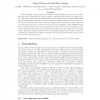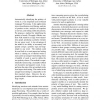2310 search results - page 207 / 462 » Coloring Random Graphs |
DM
2010
13 years 8 months ago
2010
A labeling of a graph G is distinguishing if it is only preserved by the trivial automorphism of G. The distinguishing chromatic number of G is the smallest integer k such that G ...
SODA
1997
ACM
13 years 9 months ago
1997
ACM
We give a polynomial-time algorithm for the following problem: Given a degree sequence in which each degree is bounded from above by a constant, select, uniformly at random, an un...
SODA
2004
ACM
13 years 9 months ago
2004
ACM
We consider the problem of finding a sparse set of edges containing the minimum spanning tree (MST) of a random subgraph of G with high probability. The two random models that we ...
ISCIS
2005
Springer
14 years 1 months ago
2005
Springer
Dense subgraphs of sparse graphs (communities), which appear in most real-world complex networks, play an important role in many contexts. Computing them however is generally expe...
ACL
2010
13 years 6 months ago
2010
Automatically identifying the polarity of words is a very important task in Natural Language Processing. It has applications in text classification, text filtering, analysis of pr...


